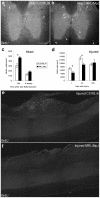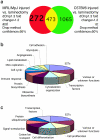Enhanced functional recovery in MRL/MpJ mice after spinal cord dorsal hemisection
- PMID: 22348029
- PMCID: PMC3278405
- DOI: 10.1371/journal.pone.0030904
Enhanced functional recovery in MRL/MpJ mice after spinal cord dorsal hemisection
Abstract
Adult MRL/MpJ mice have been shown to possess unique regeneration capabilities. They are able to heal an ear-punched hole or an injured heart with normal tissue architecture and without scar formation. Here we present functional and histological evidence for enhanced recovery following spinal cord injury (SCI) in MRL/MpJ mice. A control group (C57BL/6 mice) and MRL/MpJ mice underwent a dorsal hemisection at T9 (thoracic vertebra 9). Our data show that MRL/MpJ mice recovered motor function significantly faster and more completely. We observed enhanced regeneration of the corticospinal tract (CST). Furthermore, we observed a reduced astrocytic response and fewer micro-cavities at the injury site, which appear to create a more growth-permissive environment for the injured axons. Our data suggest that the reduced astrocytic response is in part due to a lower lesion-induced increase of cell proliferation post-SCI, and a reduced astrocytic differentiation of the proliferating cells. Interestingly, we also found an increased number of proliferating microglia, which could be involved in the MRL/MpJ spinal cord repair mechanisms. Finally, to evaluate the molecular basis of faster spinal cord repair, we examined the difference in gene expression changes in MRL/MpJ and C57BL/6 mice after SCI. Our microarray data support our histological findings and reveal a transcriptional profile associated with a more efficient spinal cord repair in MRL/MpJ mice.
Conflict of interest statement
Figures






Similar articles
-
Robust axonal growth and a blunted macrophage response are associated with impaired functional recovery after spinal cord injury in the MRL/MpJ mouse.Neuroscience. 2008 Oct 15;156(3):498-514. doi: 10.1016/j.neuroscience.2008.08.013. Epub 2008 Aug 19. Neuroscience. 2008. PMID: 18786615 Free PMC article.
-
Proliferating NG2-Cell-Dependent Angiogenesis and Scar Formation Alter Axon Growth and Functional Recovery After Spinal Cord Injury in Mice.J Neurosci. 2018 Feb 7;38(6):1366-1382. doi: 10.1523/JNEUROSCI.3953-16.2017. Epub 2017 Dec 26. J Neurosci. 2018. PMID: 29279310 Free PMC article.
-
Uncorrelated healing response of tendon and ear injuries in MRL highlight a role for the local tendon environment in driving scarless healing.Connect Tissue Res. 2018 Sep;59(5):472-482. doi: 10.1080/03008207.2018.1485665. Epub 2018 Jun 21. Connect Tissue Res. 2018. PMID: 29929396 Free PMC article.
-
Altered CNS response to injury in the MRL/MpJ mouse.Neuroscience. 2004;127(4):821-32. doi: 10.1016/j.neuroscience.2004.05.057. Neuroscience. 2004. PMID: 15312895
-
Regeneration of articular cartilage in healer and non-healer mice.Matrix Biol. 2014 Oct;39:50-5. doi: 10.1016/j.matbio.2014.08.011. Epub 2014 Aug 28. Matrix Biol. 2014. PMID: 25173437 Free PMC article. Review.
Cited by
-
C57BL/6 and Swiss Webster Mice Display Differences in Mobility, Gliosis, Microcavity Formation and Lesion Volume After Severe Spinal Cord Injury.Front Cell Neurosci. 2018 Jun 21;12:173. doi: 10.3389/fncel.2018.00173. eCollection 2018. Front Cell Neurosci. 2018. PMID: 29977191 Free PMC article.
-
Inflammation and Its Correlates in Regenerative Wound Healing: An Alternate Perspective.Adv Wound Care (New Rochelle). 2014 Sep 1;3(9):592-603. doi: 10.1089/wound.2014.0528. Adv Wound Care (New Rochelle). 2014. PMID: 25207202 Free PMC article. Review.
-
Enhanced cartilage repair in 'healer' mice-New leads in the search for better clinical options for cartilage repair.Semin Cell Dev Biol. 2017 Feb;62:78-85. doi: 10.1016/j.semcdb.2016.04.018. Epub 2016 Apr 26. Semin Cell Dev Biol. 2017. PMID: 27130635 Free PMC article. Review.
-
The LG/J murine strain exhibits near-normal tendon biomechanical properties following a full-length central patellar tendon defect.Connect Tissue Res. 2016 Nov;57(6):496-506. doi: 10.1080/03008207.2016.1213247. Epub 2016 Aug 23. Connect Tissue Res. 2016. PMID: 27552106 Free PMC article.
-
Improved biomechanical and biological outcomes in the MRL/MpJ murine strain following a full-length patellar tendon injury.J Orthop Res. 2015 Nov;33(11):1693-703. doi: 10.1002/jor.22928. Epub 2015 May 25. J Orthop Res. 2015. PMID: 25982892 Free PMC article.
References
-
- Thuret S, Moon LD, Gage FH. Therapeutic interventions after spinal cord injury. Nat Rev Neurosci. 2006;7:628–643. - PubMed
-
- Chen MS, Huber AB, van der Haar ME, Frank M, Schnell L, et al. Nogo-A is a myelin-associated neurite outgrowth inhibitor and an antigen for monoclonal antibody IN-1. Nature. 2000;403:434–439. - PubMed
-
- Davies SJ, Fitch MT, Memberg SP, Hall AK, Raisman G, et al. Regeneration of adult axons in white matter tracts of the central nervous system. Nature. 1997;390:680–683. - PubMed
-
- Neumann S, Woolf CJ. Regeneration of dorsal column fibers into and beyond the lesion site following adult spinal cord injury. Neuron. 1999;23:83–91. - PubMed
Publication types
MeSH terms
LinkOut - more resources
Full Text Sources
Other Literature Sources
Medical

